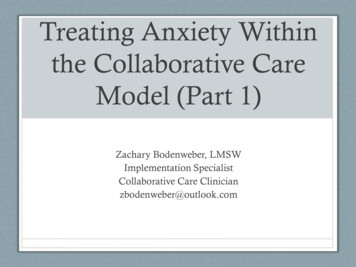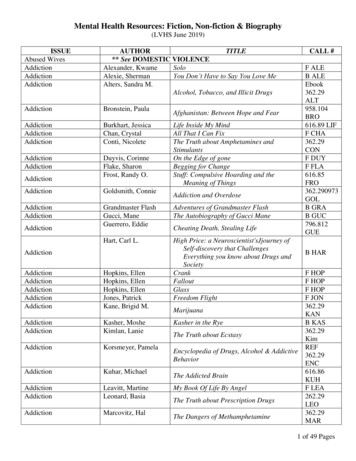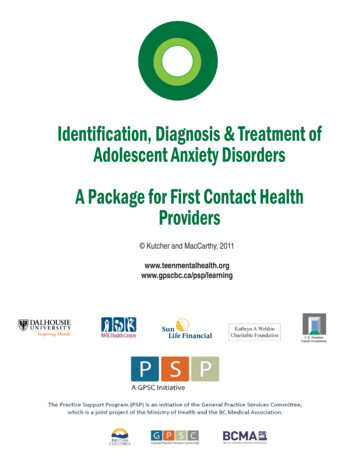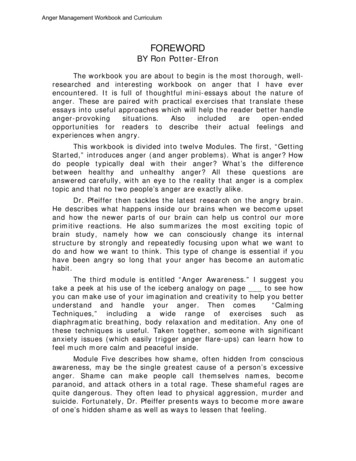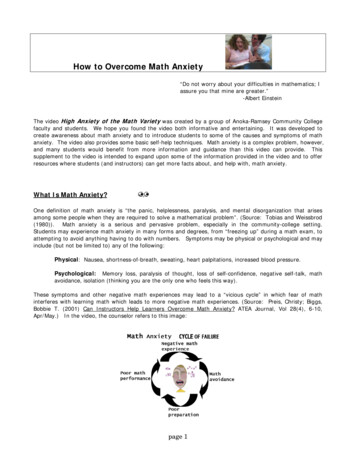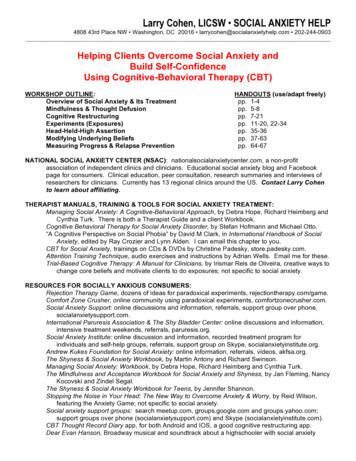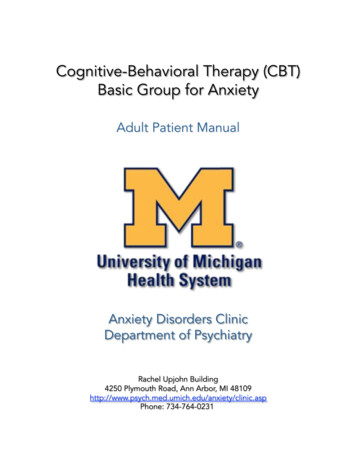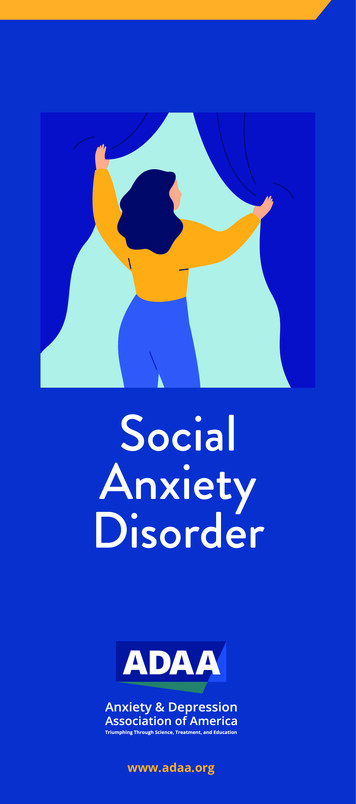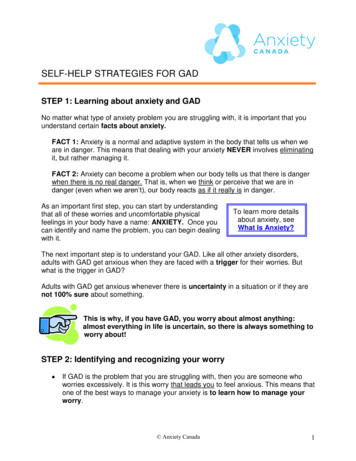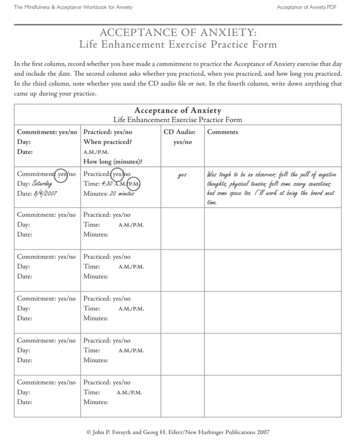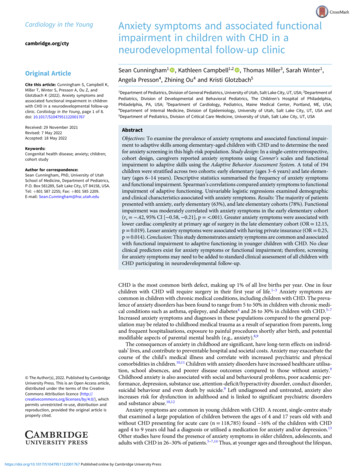
Transcription
Cardiology in the Youngcambridge.org/ctyOriginal ArticleCite this article: Cunningham S, Campbell K,Miller T, Winter S, Presson A, Ou Z, andGlotzbach K (2022). Anxiety symptoms andassociated functional impairment in childrenwith CHD in a neurodevelopmental follow-upclinic. Cardiology in the Young, page 1 of 8.doi: 10.1017/S1047951122001767Received: 29 November 2021Revised: 7 May 2022Accepted: 18 May 2022Keywords:Congenital health disease; anxiety; children;cohort studyAuthor for correspondence:Sean Cunningham, PhD, University of UtahSchool of Medicine, Department of Pediatrics,P.O. Box 581289, Salt Lake City, UT 84158, USA.Tel: þ801 587 2255; Fax: þ801 585 2209.E-mail: Sean.Cunningham@hsc.utah.edu The Author(s), 2022. Published by CambridgeUniversity Press. This is an Open Access article,distributed under the terms of the CreativeCommons Attribution licence (http://creativecommons.org/licenses/by/4.0/), whichpermits unrestricted re-use, distribution andreproduction, provided the original article isproperly cited.Anxiety symptoms and associated functionalimpairment in children with CHD in aneurodevelopmental follow-up clinicSean Cunningham1 , Kathleen Campbell1,2 , Thomas Miller3, Sarah Winter1,Angela Presson4, Zhining Ou4 and Kristi Glotzbach51Department of Pediatrics, Division of General Pediatrics, University of Utah, Salt Lake City, UT, USA; 2Department ofPediatrics, Division of Developmental and Behavioral Pediatrics, The Children’s Hospital of Philadelphia,Philadelphia, PA, USA; 3Department of Cardiology, Pediatrics, Maine Medical Center, Portland, ME, USA;4Department of Internal Medicine, Division of Epidemiology, University of Utah, Salt Lake City, UT, USA and5Department of Pediatrics, Division of Critical Care Medicine, University of Utah, Salt Lake City, UT, USAAbstractObjectives: To examine the prevalence of anxiety symptoms and associated functional impairment to adaptive skills among elementary-aged children with CHD and to determine the needfor anxiety screening in this high-risk population. Study design: In a single-centre retrospective,cohort design, caregivers reported anxiety symptoms using Conner’s scales and functionalimpairment to adaptive skills using the Adaptive Behavior Assessment System. A total of 194children were stratified across two cohorts: early elementary (ages 3–6 years) and late elementary (ages 6–14 years). Descriptive statistics summarised the frequency of anxiety symptomsand functional impairment. Spearman’s correlations compared anxiety symptoms to functionalimpairment of adaptive functioning. Univariable logistic regressions examined demographicand clinical characteristics associated with anxiety symptoms. Results: The majority of patientspresented with anxiety, early elementary (63%), and late elementary cohorts (78%). Functionalimpairment was moderately correlated with anxiety symptoms in the early elementary cohort(rs .42, 95% CI [ 0.58, 0.21], p .001). Greater anxiety symptoms were associated withlower cardiac complexity at primary age of surgery in the late elementary cohort (OR 12.15,p 0.019). Lesser anxiety symptoms were associated with having private insurance (OR 0.25,p 0.014). Conclusion: This study demonstrates anxiety symptoms are common and associatedwith functional impairment to adaptive functioning in younger children with CHD. No clearclinical predictors exist for anxiety symptoms or functional impairment; therefore, screeningfor anxiety symptoms may need to be added to standard clinical assessment of all children withCHD participating in neurodevelopmental follow-up.CHD is the most common birth defect, making up 1% of all live births per year. One in fourchildren with CHD will require surgery in their first year of life.1–3 Anxiety symptoms arecommon in children with chronic medical conditions, including children with CHD. The prevalence of anxiety disorders has been found to range from 5 to 50% in children with chronic medical conditions such as asthma, epilepsy, and diabetes4 and 26 to 30% in children with CHD.5–7Increased anxiety symptoms and diagnoses in these populations compared to the general population may be related to childhood medical trauma as a result of separation from parents, longand frequent hospitalisations, exposure to painful procedures shortly after birth, and potentialmodifiable aspects of parental mental health (e.g., anxiety).8,9The consequences of anxiety in childhood are significant, have long-term effects on individuals’ lives, and contribute to preventable hospital and societal costs. Anxiety may exacerbate thecourse of the child’s medical illness and correlate with increased psychiatric and physicalcomorbidities in children.10,11 Children with anxiety disorders have increased healthcare utilisation, school absences, and poorer disease outcomes compared to those without anxiety.9Childhood anxiety is also associated with social and behavioural problems, poor academic performance, depression, substance use, attention-deficit/hyperactivity disorder, conduct disorder,suicidal behaviour and even death by suicide.9 Left undiagnosed and untreated, anxiety alsoincreases risk for dysfunction in adulthood and is linked to significant psychiatric disordersand substance abuse.10,12Anxiety symptoms are common in young children with CHD. A recent, single-centre studythat examined a large population of children between the ages of 4 and 17 years old with andwithout CHD presenting for acute care (n 118,785) found 16% of the children with CHDaged 4 to 9 years old had a diagnosis or utilised a medication for anxiety and/or depression.13Other studies have found the presence of anxiety symptoms in older children, adolescents, andadults with CHD in 26–30% of patients.5–7,14 Thus, at younger ages and throughout the lifespan,https://doi.org/10.1017/S1047951122001767 Published online by Cambridge University Press
2anxiety and anxiety symptoms have been found in individuals withCHD with associated deleterious outcomes.In 2012, the American Academy of Pediatrics and theAmerican Heart Association released a scientific statement providing an assessment structure for the longitudinal neurodevelopmental evaluation and care for high-risk children with CHD.15International consortiums and working groups have subsequentlyoutlined specific batteries of standardised and validated measuresintended to capture the neurodevelopmental vulnerabilities in theclinical care and treatment of children with CHD.16,17 Broad-basedbehavioural measures are recommended; however, targeted anxiety symptom assessments are not a suggested component of coreassessment batteries during routine neurodevelopmental followup. Anxiety assessments are suggested starting for children ages6 years old and reaching into young adulthood; however, youngerchildren have the potential for deleterious anxiety, but screening isnot recommended for this age group. Given the presence of anxietyin younger-aged children (i.e., 4 years), anxiety symptom screeningmay be necessary, yet missing, as a targeted area of assessmentacross a wider age spectrum to capture the full age range of childrenwho may be experiencing anxiety in routine neurodevelopmentalfollow-up visits.Children with CHD are at a greater risk for neurodevelopmental challenges and psychological disorders. Neurodevelopmental follow-up programmes are designed to providescreening for psychological disorders and can be a part of clinical care where anxiety conditions are identified in children withCHD. Given the effects of anxiety in children with CHD on theindividual and society, early and proper identification and treatment of anxiety disorders has been proposed in the literature.11Information on the prevalence of anxiety symptoms identifiedin neurodevelopmental follow-up programmes may help guideresearch priorities, clinical care, and allocation of healthcareresources. Therefore, it is important to know how commonsymptoms of anxiety are in children with CHD routinelyscreened for psychological conditions, such as in neurodevelopmental follow-up programmes.Children with CHD are at greater risk for neurodevelopmental challenges (e.g., neuropsychiatric functioning) when compared to the general population. Thus, it is important toknow how common anxiety and associated functional impairment to adaptive skills are across the age spectrum of childrenwith CHD. There may be ways to improve the current system ofevaluating anxiety in a population of children with anxietysymptoms, including patients who may be going underidentified for early and appropriate treatment of anxiety-relatedsymptoms in neurodevelopmental follow-up programmes. Thecurrent literature lacks systematic exploration of younger childrenunder routine follow-up neurodevelopmental care specificallyfor anxiety symptoms. Additionally, current studies have notexamined associated functional impairments related to anxiety.Examining younger children specifically for anxiety and associatedfunctional impairments can assist in early identification and treatment efforts. Given the paucity of studies that examine anxietysymptoms across a wide age spectrum of children with CHD,and associated functional impairment, we aimed to study elementary-aged children under routine care in a large, neurodevelopmental follow-up programme to determine if anxiety symptomsare present across the elementary age spectrum and how thosesymptoms correlate with functional impairments. Althoughthere are several ways that children can be followed up for care,our centre utilises an interdisciplinary 122001767 Published online by Cambridge University PressS. Cunningham et al.follow-up programme to assess for neuropsychiatric and developmental challenges among children with CHD.Materials and methodsStudy and patientsOur design is a retrospective, single-centre, cohort study of children aged 3–14 with CHD who underwent neuropsychologicalevaluations between July 2015 and June 2020. All patients met criteria for longitudinal cardiac neurodevelopmental follow-up programme based on the American Heart Association guidelines forhigh-risk CHD.15 Patients were included if they had CHD andunderwent catheter based or surgical intervention. Patients werescreened for anxiety symptoms as part of an outpatient, interdisciplinary neurodevelopmental follow-up clinic visit. Each interdisciplinary clinic visit is staffed by a developmental paediatrician,cardiologist, psychologist, speech and language pathologist, nurse,and physical therapist who perform assessments in their respectivefields. Children were stratified into two groups contingent on ageand neuropsychiatric measure. Children aged 3–6 years were classified in the early elementary cohort, and children aged 6–14 werein the late elementary cohort. Three children aged 6 years old fromthe early elementary cohort were given the measure for the oldercohort and were included in late elementary cohort for analysis.The study was approved by the University of Utah InstitutionalReview Board and was exempt from patient and parental consent.Demographic and clinical variablesDemographic and clinical variables were collected from the electronic medical record.18 Cardiac anatomy at the time of the indexoperation was grouped into two categories: (1) single ventricle and(2) two ventricle. Risk Adjustment for Congenital Heart Surgery-1(RACHS-1) scoring system was used to define the index surgicalcomplexity [low complexity 1–2; medium complexity 3–4;high complexity 5–6].Critical CHD was defined as requiring surgery in the first yearof life. Post-operative complications (intraventricular haemorrhage, stroke, seizure, arrhythmia, extracorporeal membraneoxygenation, necrotising enterocolitis, pacemaker placement,thrombosis, and systemic ventricular dysfunction) were combinedto create a dichotomous variable and categorised as yes if the childexperienced one or more complication during their index hospitalstay. A dichotomisation of cardiac complications was necessary asthe frequency of complications did not allow for group comparison. Insurance coverage was categorised as commercial (private),Medicaid (public), or self-pay. Annual household income as a surrogate for socioeconomic status was approximated with medianhousehold income by county/zip code and treated as a continuousvariable for analysis.19Measures of anxiety symptomsThe Conners Early Childhood is a norm-referenced, caregiverrated measure of behavioural, emotional, social, and developmental milestones in children aged 2 to 6 years old.20 The Conners EarlyChildhood identifies anxious symptoms using a T-score system.20,21Anxiety symptoms are defined at a T-score on the Anxiety scaleat T 60, equal to or greater than one standard deviation abovethe population mean (i.e., M 50; SD 10).20 Conners EarlyChildhood T-scores below 60 indicate a “low score” or “averagescore” and were not considered consistent with anxiety symptoms.
Cardiology in the YoungThe Conners Comprehensive Behavior Rating Scales is a normreferenced caregiver-rated measure of childhood disorders basedon the Diagnostic and Statistical Manual of Mental Disorders(DSM-IV-TR; American Psychiatric Association, 2000).22 TheConners Comprehensive Behavior Rating Scales assesses childrenaged 6 to 18 years old. The Conners Comprehensive BehaviorRating Scales examined the presence of anxiety symptoms asdefined by Diagnostic and Statistical Manual of Mental Disorderscriteria; each manifestation relates to distinct anxiety diagnosesincluding generalised anxiety disorder, separation anxiety disorder, social phobia, and obsessive-compulsive disorder. The authorsof the Conners Comprehensive Behavior Rating Scales offer thesame interpretation of anxiety symptom presence, whereas measurement is based on T-score and is defined by the same parameters as the Conners Early Childhood.22 Thus, as with the ConnersEarly Childhood, the presence of anxiety symptoms on the ConnersComprehensive Behavior Rating Scales and Diagnostic andStatistical Manual of Mental Disorders Scales was defined byT-scores, T 60, equal to or greater than one standard deviationabove the population mean; scores below 60 indicate a “low score”or “average score” and were not considered consistent with anxietysymptoms.22 The Conners Comprehensive Behavior Rating Scaleshave an internal consistency ranging from .69 to .96.Measure of functional impairmentThe Adaptive Behavior Assessment System, Third Edition measuresfunctional impairment to adaptive skills by obtaining caregiverratings across a number of different developmental skill areasquantified into an overall Global Composite Scale.23 The GlobalComposite Scale is comprised from separate composite scoresthat each have a specific focal area of development, conceptualcomposite (i.e., communication, academics, self-direction),social composite (i.e., leisure, social skills), and a practicalcomposite (i.e., community use, home living, health and safety,self-care). Functional impairment on the global composite scalewas defined by a standard score of 85, one standard deviationor greater below the population mean for each of the global andcomposite scales.Statistical analysisAge and hospital length of stay were summarised by using medianand interquartile range due to distribution skew. Next, countsand percentages for categorical variables were reported.Univariate logistic regression models were computed for eachcohort to examine the association between demographic andclinical variables and anxiety. Since the Risk Adjustment forCongenital Heart Surgery had few patients in the low complexity group, Firth’s penalised logistic regression was used toreduce bias. Odds ratios and 95% confidence intervals werereported. The value of correlation ranges between 1 and 1,where 0 means no monotonic relationship. The ranges of 0.0–0.1, 0.1–0.4, 0.4–0.7, 0.7–0.9, 0.9–1.0 correspond to the strengthof relationship being negligible, weak, moderate, strong andvery strong as a rule-of-thumb.24 The monotonic pairwiseevaluated associations between anxiety domains and functionalcomposites using Spearman’s rank correlations within eachcohort. Correlation coefficients (rs), their 95% confidence intervals, and their asymptotic p-values are used to report relationships between variables of anxiety and functional adaptive skills.https://doi.org/10.1017/S1047951122001767 Published online by Cambridge University Press3Statistical significance was assessed at the 0.05 level. Statisticalanalyses were implemented using R v. 4.0.3.25ResultsDemographic and clinical characteristics for the sample are outlined in Table 1. Our total sample consisted of 194 participants,78 children in the early elementary cohort and 116 in the lateelementary cohort. The median age was 4.8 years (interquartilerange 4.3, 6.0) in the early elementary cohort and 9.3 years (interquartile range 8.2, 11.8) in the late elementary cohort. In bothgroups, participants were mostly male, Caucasian, had privateinsurance, and were RACHS-3 and 4 surgical cases. The majorityof patients had two ventricle physiology, 69% in the early elementary group and 53% in the late elementary group. Sixty-six per centof the full cohort experienced at least one complication: intraventricular haemorrhage (0%), arrhythmia (41%), extracorporealmembrane oxygenation (2%), necrotising enterocolitis (10%),pacemaker (8%), stroke (8%), seizure (8%), thrombosis (17%), systolic dysfunction (23%), and infection (7%).In the early elementary cohort, 63% of children showed anxietysymptoms, whereas in the late elementary cohort 78% showedanxiety symptoms. The median anxiety T-score on the ConnersEarly Childhood was 67.5 (interquartile range 4.3, 6.0). In the lateelementary cohort, median T-scores for the DSM-IV scales of theConners Comprehensive Behavior Rating Scales were as follows:generalised anxiety disorder, median 69.3 (interquartile range58.8, 82.0); separation anxiety disorder, median 59.0 (interquartilerange 49.0, 75.0); social phobia, median 57.0 (interquartile range48.0, 71.0); and obsessive-compulsive disorder, median 53.0 (interquartile range 46.0, 66.0). Figure 1 illustrates the score distributionof the anxiety scales across the early and late elementary cohorts.Global functional impairment was present in 49% of children inthe early elementary cohort (Adaptive Behavior AssessmentSystem, Third Edition median 86.0, interquartile range 75.5,94.0) and 39% in the late elementary cohort (Adaptive BehaviorAssessment System, Third Edition median 90.0, interquartilerange 80.8, 97.0). In the early elementary cohort, of childrenexperiencing anxiety symptoms, 61% also had global functionalimpairment. In the late elementary cohort, of those childrenexperiencing anxiety symptoms, 42% had associated functionalimpairment. There was a statistically significant difference inglobal functional impairment within groups. In the early elementary cohort, children with the presence of anxiety symptoms hadmore global functional impairment (61%) when compared to thosewho did not have anxiety symptoms (32%), p .05. Figure 2 illustrates the percentage of functional impairments across the earlyand late elementary cohorts.We utilised Spearman’s rank correlation coefficients and their95% confidence intervals to examine functional composites andanxiety symptoms for the early elementary cohort and anxiety disorder domains for the late elementary cohort. In the early elementary cohort, anxiety scores were correlated with functionalimpairment (negatively correlated with scores of functioning) inall areas of adaptive functioning: moderate correlation with thegeneral adaptive composite, rs .42, 95% CI [ 0.58, 0.21], p .001 and conceptual composite, rs .41, 95% CI [ 0.58, 0.21], p .001; weak correlation with the practical composite,rs .30, 95% CI [ 0.49, 0.09], p .001; and the socialcomposite, rs .28, 95% CI [ 0.48, 0.05], p .001.
4S. Cunningham et al.Table 1. Patient population: clinical and demographic characteristics stratifiedby age groups. n 194. Values are frequencies (%) for categorical variables andmedian (interquartile range,) for continuous variablesEarlyelementaryLateelementary(n 78)(n 116)Anxiety symptoms49 (63)91 (78)Global functional impairment35 (45)44 (38)4.8 (4.3, 6.0)9.3 (8.2, 11.8)57 (73)69 (59)Private49 (64)80 (69)Medicaid26 (34)31 (27)Self-pay2 (3)5 (4)Caucasian60 (77)103 (89)Other or declined to answer18 (23)13 (11)Age at evaluation in yearsSexMaleInsuranceRaceFamily income 30,000–50,0005 (6)5 (4) 50,000–70,00055 (71)89 (77) 70,000–90,00018 (23)22 (19)Single ventricle24 (31)53 (46)Two ventricle54 (69)63 (54)Yes35 (45)53 (46)No39 (50)58 (50)4 (5)5 (4)Low complexity13 (17)19 (16)Medium complexity40 (51)53 (46)High complexity21 (27)39 (34)4 (5)5 (4)Index surgery hospitalisationlength (days)16.5 (10, 28.5)14.5 (7.0, 27.2)Age at first operation (days)10.0 (6.8, 63.0)8.5 (5.0, 34.5)Yes50 (64)74 (64)No28 (36)42 (36)024 (32)28 (24)1–340 (53)63 (54)4þ12 (15)25 (22)Cardiac anatomyPrenatal diagnosisUnknownRACHSScoring not applicable (no surgery)ComplicationsNumber of medications at follow-upAbbreviations: RACHS – risk adjustment for congenital heart surgery.https://doi.org/10.1017/S1047951122001767 Published online by Cambridge University PressIn the late elementary cohort, symptoms of generalised anxietydisorder were weakly or moderately correlated with all areas offunctional impairment; general adaptive composite, rs .26,95% CI [ 0.42, 0.05], p .008; conceptual composite, rs .36, 95% CI [ 0.52, 0.18], p .001; practical composite, rs .26, 95% CI [ 0.45, 0.05], p .008; and the social composite,rs .21, 95% CI [ 0.38, 0.02], p .034. Social anxiety disordersymptoms were weakly correlated with lower scores on the conceptual composite rs .26, 95% CI [ 0.46, 0.07], p .007and social skills composite rs .24, 95% CI [ 0.42, 0.04],p .015. Obsessive-compulsive disorder and separation anxietydisorder symptoms were not correlated with lower level of functional impairment to adaptive skills.In the univariable logistic regression, there was an associationbetween anxiety symptoms and insurance type, with less anxietysymptoms in children having private insurance when comparedto those with public insurance or self-pay in the early elementarycohort (OR 0.25, 95% CI [0.10, 0.7], p 0.014). This relationshipwas not present in the late elementary cohort. Lower cardiac complexity at primary surgery was associated with increased anxietysymptoms compared to high complexity in the late elementarycohort (OR 12.15, 95% CI [1.4, 1598.89], p 0.019. There wereno associations between the presence of anxiety and any otherdemographic and clinical variables for the early elementary or lateelementary cohorts (Table 2).DiscussionOur study examined the prevalence of anxiety symptoms andassociated functional impairment to adaptive skills in elementary-aged children with CHD in a single-centre neurodevelopmental follow-up programme. We identified anxiety symptomsin 63% of our early elementary cohort and 78% in our lateelementary CHD cohort. This prevalence exceeds the prevalence of anxiety symptoms in the general population and othermedicalised populations.4,26 Anxiety symptoms correlated withfunctional impairment to adaptive skills in both the youngerand older age cohorts. More specifically, we found associationsbetween anxiety symptoms and a broader scope of functionalimpairments to adaptive skills in the younger elementary group,demonstrating more functional impairment in early elementaryages when anxiety is present, than when compared to the olderelementary group. With regard to clinical and demographic variables, anxiety symptoms were associated with lower cardiaccomplexity at primary age of surgery in the later elementarycohort, and in the early elementary cohort, having private insurance. However, overall no clear clinical profile emerged to suggest risk of anxiety symptoms in any patient group in particular.Our findings built upon on previous studies indicating there isan increased prevalence of anxiety symptoms in children withCHD13 and expanded to determine if targeted anxiety assessmentwould capture anxiety symptoms across the age spectrum, especially in younger ages, for purposes of preventative interventions.Our results demonstrate a high prevalence of anxiety symptomswith associated functional impairment in adaptive skills in a younger at risk patient population of children with CHD. That is, agreater association was demonstrated between the presence ofanxiety symptoms and functional impairment in the younger-aged
Cardiology in the Young5Figure 1. Prevalence of anxiety symptoms forearly and late elementary cohorts.Figure 2. Percent of cohort with functionalimpairment.cohort studied, illustrating unique needs in this population foridentification and intervention. Thus, without anxiety-specificscreening targeted towards younger ages administered during routine neurodevelopmental evaluations that assess for neuropsychiatric outcomes, a context that can provide access to interventions,anxiety symptoms may not be identified. Additionally, consideration of the use of parent report survey tools to measure anxietysymptoms in young children with CHD can work to eliminatethe threats to validity that may occur with self-report assessmentsat younger ages.27When considering the impact of anxiety symptoms on functional impairment to adaptive functioning skills, it is importantto study adaptive functioning across age groups. In the currentstudy, the pathway from anxiety to functional impairment didnot follow the same pattern among each cohort, implying separateaetiologies at play and an area of further investigation. Moreimportantly, with more severe associations between anxiety andfunctional impairments in the younger-aged group, a greater needemerges to identify this population for 7 Published online by Cambridge University PressAnxiety symptoms were associated with lower cardiac surgicalcomplexity, RACHS-1 category 1 and 2, in the late elementarycohort. This is discrepant from other studies and our assumptionthat higher surgical complexity would be associated with more significant comorbidities and thus anxiety symptoms. There is conflicting evidence in the literature about the association betweenanxiety and complexity of cardiac defects.6,28–30 There was inconsistency in our findings as they relate to clinical and demographicvariables and associations to anxiety symptoms and previous studies on anxiety in children with CHD. In our study, the discrepancybetween surgical complexity and anxiety symptoms may be relatedto the limitations of the RACHS-1 score. For example, 53% ofchildren in the late elementary cohort had single ventricle heartdisease but a larger proportion of patients in the low or mediumcomplexity surgical group. This reflects the fact that the RACHS-1categorisation system includes procedures commonly used forsingle ventricle palliation (i.e., aortic to pulmonary shunts, cavopulmonary anastomoses, and pulmonary artery banding) inthe RACHS-1 category 2 and 3. Newer, validated surgical risk
6S. Cunningham et al.Table 2. Univariate analysis of association of demographic and clinical factors with anxiety symptoms in each age groupEarly elementaryLate elementaryVariablesOR (95% CI)p-valueOR (95% CI)p-valueAge at evaluation (years)0.93 (0.6, 1.5)0.751.03 (0.8, 1.3)0.80Sex:Male0.8 (0.3, 2.2)0.670.63 (0.2, 1.6)0.33Female––––Insurance:PrivatePublic or self-pay0.25 (0.1, 0.7)–0.014*–1.67 (0.7, 4.2)–0.28–Race:White or CaucasianOtherFamily income by county0.8 (0.3, 2.4)–0.70–1.1 (0.2, 4.0)–0.89–1.24 (0.4, 4.0)0.703.24 (0.9, 21.3)0.131.69 (0.6,4.6)0.290.88 (0.4, 2.1)0.77Cardiac anatomy:Two ventricleSingle ventricle––––Prenatal diagnosis:YesNo or unknown0.51 (0.2, 1.3)–0.16–0.72 (0.3, 1.8)–0.48–RACHS:Low complexity or not applicable1.45 (0.36, 6.24)0.6012.15 (1.4, 1598.89)Medium complexity2.12 (0.71, 6.42)0.180.71 (0.27, 1.77)High complexityIndex surgery hospitalisation length (days)–––0.019*0.46–1.01 (0.9, 1.03)0.561.01 (1.01, 1.03)0.511 (1.0, 1.0)0.931.01 (1.0, 1.02)0.174þ1.8 (0.4, 9.7)0.462 (0.5, 10.4)0.371–30.9 (0.3, 2.5)0.840.8 (0.3, 2.3)0.68Age at first operation (days)Number of medications:–––Yes1 (0.4, 2.7) 0.990.79 (0.3, ons: RACHS – risk adjustment for congenital heart surgery.*p-value 0.05.classification systems may be more effective to ameliorate thesediscrepancies in future studies. The lack of a clear clinical profilefor anxiety symptoms and lower surgical complexity might alsobe related to programmatic and provider referral bias. Many ofour youngest patients are automatically referred at the time oftheir principal surgical discharge and identified at high risk forneurodevelopmental impairment based on the American HeartAssociation criterion for evaluation. Older patients are moreoften seen in our clinic due to specific physician or parental concern for developmental delay, behaviour challenges, or mentalhealth impairment. Additionally, this may also represent anera effect that as our programme started, we were seeing olderpatients by physician referral for neurodevelopmental concerns.Our group previously demonstrated this referral bias and clearhttps://doi.org/10.1017/S1047951122001767 Published online by Cambridge University Pressbenefit of neurodevelopmental evaluation regardless of anatomic lesion or surgical complexity.31 This suggests that inthe absence of a clinical phenotype that predicts anxiety symptoms, all patients regardless of age, lesion or surgical complexityshould be screened during routine follow-up visits.There was a higher frequency of anxiety symptoms in the lateelementary group. This may be due to greater awareness ofmedical procedures and risk to life.
and substance abuse.10,12 Anxiety symptoms are common in young children with CHD. A recent, single-centre study that examined a large population of children between the ages of 4 and 17 years old with and without CHD presenting for acute care (n 118,785) found 16% of the children with CHD
